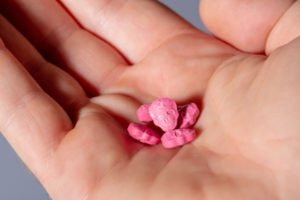Ecstasy is a psychoactive drug that is almost exclusively used for recreational purposes in the United States. It goes by many names including E, Molly, and Mandy, but they all refer to MDMA, a drug that offers euphoria, empathogenic, and psychedelic properties.
It’s most active in club scenes and doesn’t have any currently accepted medical uses. However, like other drugs, it was first created as a byproduct rather than an intentionally synthesized drug.
Learn more about how ecstasy was created and how it became one of the most popular club drugs in the United States.
What is Ecstasy?
Ecstasy refers to MDMA, or 3,4-Methylenedioxymethamphetamine, a popular empathogen drug that’s used in party scenes as a club drug. The drug is in a class of psychoactive substances called substituted amphetamines, which means their chemical structure is similar to amphetamines like Adderall. However, in addition to stimulant effects, MDMA can also cause increased empathy, affection, and social excitability.
In some cases, it can even cause hallucinations, which isn’t common with traditional stimulants. The drug can also cause some paradoxical effects like sedation that interrupts feelings of stimulation in waves.
MDMA works in the brain by interacting with natural brain chemicals that perform a variety of functions that are closely tied to reward and motivation. These chemicals include serotonin, norepinephrine, and dopamine, which are commonly referred to as “feel-good chemicals.” MDMA causes these chemicals to be released into the brain in greater quantities than normal.
How Ecstasy Was First Created

MDMA was first synthesized in 1912 by a chemist named Anton Kӧllisch for the German pharmaceutical company Merck. The company wanted to make an antihemorrhagic medication, which is a drug that slows or stops abnormal bleeding. However, its competitor Bayer already owned the patent on a drug that was used for that purpose, so Kӧllisch set out to create an analog that could be used without infringing on the existing property.
During the creation of most drugs, it takes more than one chemical reaction before you achieve the final product. Through the process, chemists create what is called intermediate compounds with each step of the process. One of the intermediate compounds Kӧllisch created was MDMA.
Merck wasn’t interested in studying or selling this new drug at the time, but they patented it anyway, as part of the process in making their new analog.
Over the next several years, Merck returned to MDMA a few times with no significant interest until 1927. Chemist Max Oberlin began to study MDMA, looking for substances with similar properties to adrenaline or ephedrine.
He noted many of its effects on the body outside of the sympathetic nervous system, including its effects on smooth muscles and blood sugar.
The drug was studied a few more times, once by the U.S. Army in 1953 and once by Wolfgang Fruhstorfer, another Merck chemist in 1959. There was still very little interest in the drug as a pharmaceutical.
The nonmedical, recreational use of MDMA may have started in the psychedelic boom of the late 1960s. At the time, the psychedelic methylenedioxyamphetamine (MDA) was popular, and MDMA was used as an analog alternative. Later, MDA was classified as a Schedule I drug and became less available, making MDMA more popular.
Alexander Shulgin’s Research
Alexander Shulgin was a prominent chemist and psychopharmacologist that worked with a variety of psychoactive chemicals and psychedelics in the second half of the 20th century. He claims to have synthesized MDMA as part of his research with the Dow Chemical Company, which would later lead to its spread across the U.S. as a recreational drug.
When he first synthesized the substance, he didn’t immediately test its psychoactive effects. Later, in 1970, he sent the instructions to create the drug to a chemical company in Los Angeles who then sent it to a client in the midwest, which Shulgin believed to contribute to its rise in popularity in Chicago.
Shulgin heard about the positive effects of MDMA from a student, and then a colleague and, in 1976, Shulgin decided to try the drug for himself. He was impressed with its psychoactive effects. Later, he introduced it to a psychologist named Leo Zeff, who went on to use the drug in psychotherapies and also introduced it to other therapists. The psychotherapists who used the drug in their practices believed that it could remove anxiety and fear and allow patients to communicate more openly.
It was specifically used in therapies that involved relationship problems like in marriage counseling. Therapists who supported the drug’s use tried to limit its spread to avoid it being outlawed like LSD (lysergic acid diethylamide) or mescaline. However, it began to spread among psychotherapists, psychiatrists, and recreational users.
Recreational and Therapeutic Use
Recreational use of ecstasy started to grow in popularity through the 1980s. In the late 1970s, chemical manufacturers shied away from large scale production for fear that the drug would be outlawed. But personal networks of psychotherapy practitioners and users shared the drug, which they called “Adam.”
In 1976, a small market of recreational users consumed about 10,000 doses. Between 1970 and 1985, about 500,000 doses were consumed before it was subsequently outlawed. The drug was investigated in a series of DEA hearings in which expert witnesses testified that it had potential uses is psychotherapies, arguing that it should be classified as a Schedule II substance. However, the DEA administrator ruled that it should be a Schedule I drug, which means that it’s considered to have a high risk for abuse and has no currently accepted medical uses.
Before the drug was outlawed, a company called the Texas Group began manufacturing and selling the drug in the state that shared its name and other areas. As it started to look like the drug would be banned, the Texas Group ramped up production, producing and distributing more MDMA than any other network had combined in just eight months. Still, media hype around the drug’s scheduling and its dangerous effects may have acted as a catalyst that raised awareness of the drug to would-be users.
After Criminalization
After its criminalization, its use in Texas clubs began to decline. However, its association with the rave culture caused it to grow in popularity across Europe, the U.K., and then to the United States. It remained a popular drug among middle-class partygoers into the 1990s.
Despite pleas from psychologists and other proponents to reschedule the drug, it remains a Schedule II drug. On the illicit drug market, MDMA can be mixed with other more dangerous substances, which have caused dangerous and even fatal side effects.
On its own, MDMA causes nausea, cramping, muscle cramps, blurred vision, chills, and heavy sweating. In some cases, sweating can lead to dehydration, which can be dangerous. In rare cases, the drug can become neurotoxic, which means that it can damage the brain.
Seeking Help for Ecstasy Addiction at Serenity at Summit
Ecstasy doesn’t come with a high risk for chemical dependence, but it can cause psychological dependence. As a party drug, it often accompanies other substances like alcohol, cocaine, or meth that can be extremely addictive. If you or someone you know has a substance use disorder that involves ecstasy, there is help available that can lead you into lasting freedom from addiction.
Speak to an addiction treatment specialist at Serenity at Summit to learn more about the treatment options that might be available to you. Call 844-432-0416 anytime to speak to someone about the therapies that could help you achieve sobriety. The first step toward sobriety may be a call away.
(2010, August). Rediscovering MDMA (ecstasy): The role of the American chemist Alexander T. Shulgin. Retrieved from https://www.ncbi.nlm.nih.gov/pubmed/20653618
(2006, September). The origin of MDMA (ecstasy) revisited: The true story reconstructed from the original documents. Retrieved from https://www.ncbi.nlm.nih.gov/pubmed/16911722
(2010, August). Neurotoxicity of ecstasy (MDMA): An overview. Retrieved from https://www.ncbi.nlm.nih.gov/pubmed/20420572


